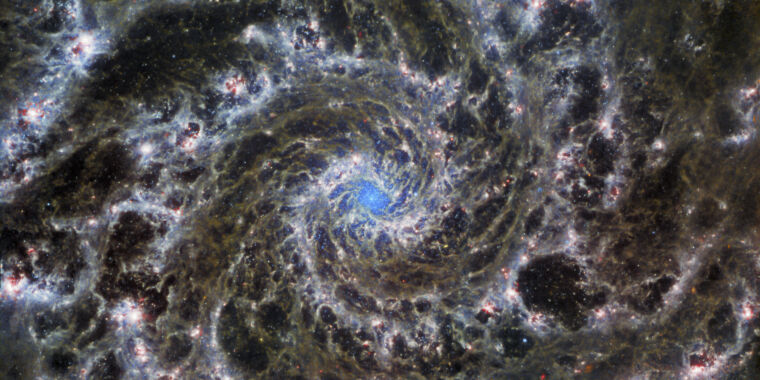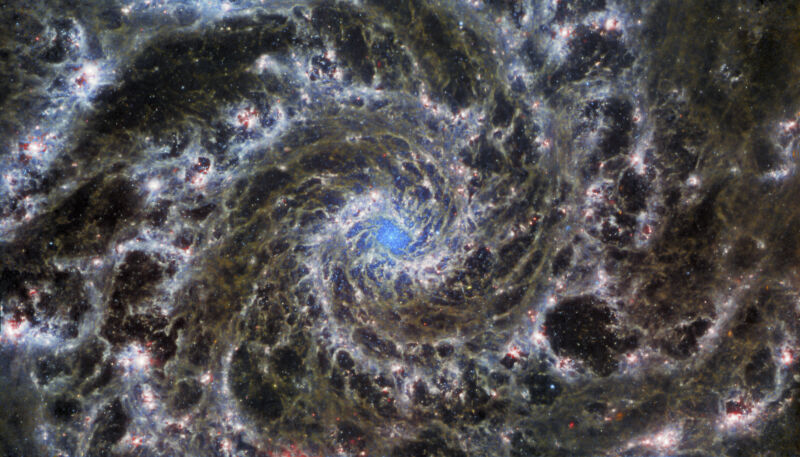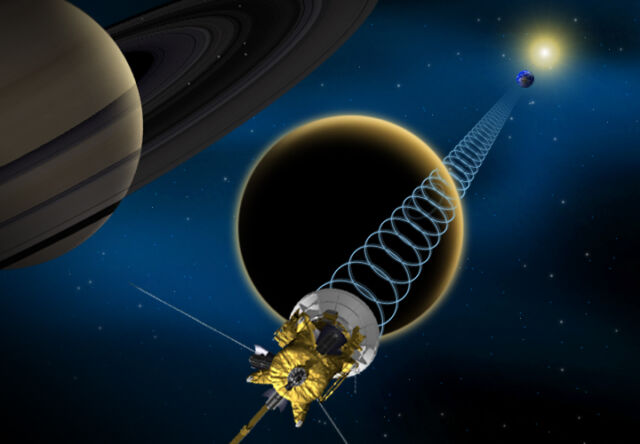There could be “dark main sequence” stars at the galactic center
Dark matter particle and antiparticle collisions could make some stars immortal.
For a star, its initial mass is everything. It determines how quickly it burns through its hydrogen and how it will evolve once it starts fusing heavier elements. It’s so well understood that scientists have devised a “main sequence” that acts a bit like a periodic table for stars, correlating their mass and age with their properties.
The main sequence, however, is based on an assumption that’s almost always true: All of the energy involved comes from the gravity-driven fusion of lighter elements into heavier ones. However, three astrophysicists consider an alternative source of energy that may apply at the very center of our galaxy— energy released when dark matter particles and antiparticles collide and annihilate. While we don’t even know that dark matter can do that, it’s a hypothetical with some interesting consequences, like seemingly immortal stars, and others that move backward along the main sequence path.
Dark annihilations
We haven’t figured out what dark matter is, but there are lots of reasons to think that it is comprised of elementary particles. And, if those behave like all of the particles we understand well, then there will be both regular and antimatter versions. Should those collide, they should annihilate each other, releasing energy in the process. Given dark matter’s general propensity not to interact with anything, these collisions will be extremely rare except in locations with very high dark matter concentrations.
The only place that’s likely to happen is at the very center of our galaxy. And, for a while, there was an excess of radiation coming from the galactic core that people thought might be due to dark matter annihilations, although it eventually turned out to have a more mundane explanation.
At the extreme densities found within a light year of the supermassive black hole at the center of our galaxy, concentrations are high enough that these collisions could be a major source of energy. And so astronomers have considered what all that energy might do to stars that end up in a black hole’s orbit, finding that under the right circumstances, dark matter destruction could provide more energy to a star than fusion.
That prompted three astrophysicists (Isabelle John, Rebecca Leane, and Tim Linden) to try to look at things in an organized fashion, modeling a “dark main sequence” of stars as they might exist within a close proximity to the Milky Way’s center.
The intense gravity and radiation found near the galaxy’s core mean that stars can’t form there. So, anything that’s in a tight orbit had formed somewhere else before gravitational interactions had pushed it into the gravitational grasp of the galaxy’s central black hole. The researchers used a standard model of star evolution to build a collection of moderate-sized stars, from one to 20 solar masses at 0.05 solar mass intervals. These are allowed to ignite fusion at their cores and then shift into a dark-matter-rich environment.
Since we have no idea how often dark matter particles might run into each other, John, Leane, and Linden use two different collision frequencies. These determine how much energy is imparted into these stars by dark matter, which the researchers simply add as a supplement to the amount of fusion energy the stars are producing. Then, the stars are allowed to evolve forward in time.
(The authors note that stars that are thrown into the grasp of a supermassive black hole tend to have very eccentric orbits, so they spend a lot of time outside the zone where dark matter collisions take place with a significant frequency. So, what they’ve done is the equivalent of having these stars experience the energy input given their average orbital distance from the galaxy’s core. In reality, a star would spend some years with higher energy input and some years with lower input as it moves about its orbit.)
Achieving immortality
The physics of what happens is based on the same balance of forces that govern fusion-powered stars, but produces some very strange results. Given only fusion power, a star will exist at a balance point. If gravity compresses it, fusion speeds up, more energy is released, and that energy causes the star to expand outward again. That causes the density drop, slowing fusion back down again.
The dark matter annihilations essentially provide an additional source of energy that stays constant regardless of what happens to the star’s density. At the low end of the mass range the researchers considered, this can cause the star to nearly shut off fusion, essentially looking like a far younger star than it actually is. That has the effect of causing the star to move backward along the main sequence diagram.
The researchers note that even lighter stars could essentially get so much additional energy that they can’t hold together and end up dissipating, something that’s been seen in models run by other researchers.
As the mass gets higher, stars reach the point where they essentially give up on fusion and get by with nothing but dark matter annihilations. They have enough mass to hold together gravitationally, but end up too diffused for fusion to continue. And they’ll stay that way as long as they continue to get additional injections of energy. “A star like this might look like a young, still-forming star,” the authors write, “but has features of a star that has undergone nuclear fusion in the past and is effectively immortal.”
John, Leane, and Linden find that the higher mass stars remain dense enough for fusion to continue even in proximity to the galaxy’s black hole. But the additional energy kept that fusion happening at a moderate rate. They proceeded through the main sequence, but at a pace that was exceptionally slow, so that running the simulation for a total of 10 billion years didn’t see them change significantly.
The other strange thing here is that all of this is very sensitive to how much dark matter annihilation is taking place. A star that’s “immortal” at one average distance will progress slowly through the main sequence if its average distance is a light year further out. Similarly, stars that are too light to survive at one location will hold together if they are a bit further from the supermassive black hole.
Is there anything to this?
The big caution is that this work only looks at the average input from dark matter annihilation. In reality, a star that might be immortal at its average distance will likely spend a few years too hot to hold together, and then several years cooling off in conditions that should allow fusion to reignite. It would be nice to see a model run with this sort of pulsed input, perhaps basing it on the orbits of some of the stars we’ve seen that get close to the Milky Way’s central black hole.
In the meantime, John, Leane, and Linden write that their results are consistent with some of the oddities that are apparent in the stars we’ve observed at the galaxy’s center. These have two distinctive properties: They appear heavier than the average star in the Milky Way, and all seem to be quite young. If there is a “dark main sequence,” then the unusual heft can be explained simply by the fact that lower mass stars end up dissipating due to the additional energy. And the model would suggest that these stars simply appear to be young because they haven’t undergone much fusion.
The researchers suggest that we could have a clearer picture if we were able to spend enough time observing the stars at our galaxy’s core with a large enough telescope, allowing us to understand their nature and orbits.
Physical Review D, 2025. DOI: Not yet available (About DOIs).
John is Ars Technica’s science editor. He has a Bachelor of Arts in Biochemistry from Columbia University, and a Ph.D. in Molecular and Cell Biology from the University of California, Berkeley. When physically separated from his keyboard, he tends to seek out a bicycle, or a scenic location for communing with his hiking boots.
There could be “dark main sequence” stars at the galactic center Read More »










